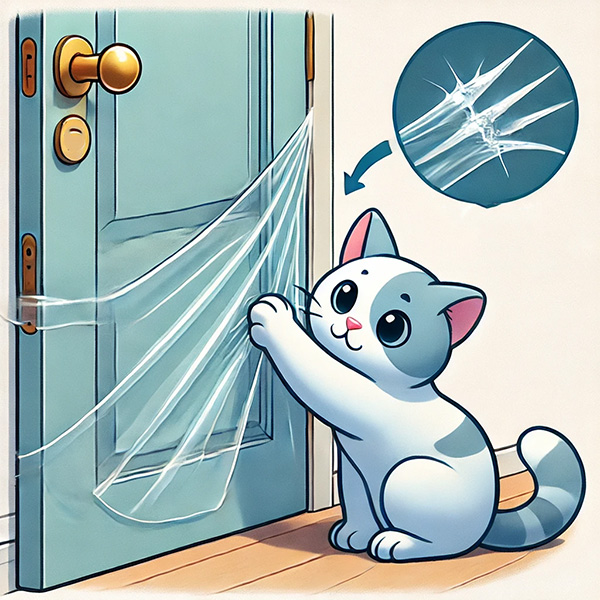Cat scratching at doors can be a nuisance, but it's a natural behavior driven by their instincts to mark territory, maintain claw health, and stretch. Understanding why your cats scratch is key to stopping this behavior effectively. Cat owners should prioritize redirection and positive reinforcement rather than punitive measures. This involves providing suitable alternatives like cat scratching posts placed near the problematic doors and engaging your cat in regular play to reduce anxiety and boredom.
Although most cat owners recognize unwanted behavior, they often don't know how to stop a cat from scratching the door effectively. In this blog post, we will discuss practical strategies for redirecting your cat's scratching behavior, ensuring your doors remain intact while keeping your furry friend happy and healthy.
7 Ways To Stop cat from scratching door
Provide Alternatives

Offering suitable alternatives is essential to prevent your cat from scratching doors. Cats have a natural need to scratch to sustain their claw health and mark their territory. In the wild, cats would scratch trees. Place scratching posts, a cat tree, or cat scratchers made from appealing materials like sisal or cardboard near the doors they frequently target. The posts should be secure and high enough for your cat to fully extend while scratching.
Additionally, placing interactive cat toys and engaging play areas near these alternatives can redirect your cat's attention and reduce unwanted scratching. Encouraging your cat to use these alternatives with positive reinforcement, such as treats and affection, will help establish good habits and stop scratching your home.
Behavioral Training

Behavioral training is an effective strategy to stop your cat from scratching doors. This method aims to divert your cat's instinctive scratching behavior toward suitable alternatives, such as scratching posts or cat trees.
Begin by placing attractive scratching surfaces near the targeted door. Use cat toys or treats to lure your cat towards these alternatives. Each time your cat uses the scratching post instead of the door, immediately reward it with praise, petting, or a treat.
Consistency is key—regularly encourage these positive behaviors to reinforce the habit. If scratching persists, gently lead your cat away from the bedroom door and guide them to the scratching post, reinforcing the correct behavior with more rewards.
Environmental Deterrents
Implementing environmental deterrents can be an effective way to discourage your cat from scratching doors. One common method involves applying double-sided tape or aluminum foil to the door. Cats dislike the sticky or unusual texture, detracting them from scratching.
Another option is a motion-activated deterrent, such as a canister that emits a harmless burst of air when the cat approaches. This surprises the cats and discourages them from returning to the area. By strategically placing these deterrents on or near doors, you can protect your surfaces while training your cat to avoid these areas without causing them distress or harm.
Calming Techniques
Calming techniques can effectively reduce stress-related behaviors in cats, such as scratching doors. One widely used method is pheromone diffusers, such as Feliway, which emit calming substances that mimic the natural pheromones cats produce. These can help soothe your cat and make them less likely to scratch as a stress response.
Moreover, playing gentle music or keeping a radio tuned to a talk station can offer a soothing presence, alleviating feelings of loneliness or anxiety. These calming techniques can create a more peaceful environment, discouraging your cat from scratching inappropriately.
Routine and Feeding Adjustments

Establishing a routine and adjusting feeding times can significantly help reduce your cat's door-scratching behavior. Cats are creatures that thrive on routine and structure. Establishing specific schedules for feeding, playtime, and rest can help stabilize your cat's day and minimize feelings of anxiety.
Feeding your cat its main meal just before bedtime can also discourage nighttime scratching by aligning its natural hunting and feeding instincts with your sleep schedule. This adjustment helps satisfy its nocturnal activities and promotes a calmer environment at night. Consistently maintaining this routine will not only help manage its scratching habits but also enhance its overall well-being.
Physical Barriers

Implementing physical barriers is a practical approach to prevent your cat from scratching doors. One effective method is to attach a clear plastic sheet to the lower part of the door where your cat usually scratches. This material is less appealing to cats due to its smooth texture and can protect the door's surface from damage. Alternatively, using a scratch guard specifically designed for doors can also serve as a deterrent, offering a protective layer that shields against claws. These barriers prevent unwanted scratching and reduce the habit over time by eliminating the tactile feedback cats seek when they scratch.
Use Double Sided Tape
Double-sided tape is a simple and effective method to deter your cat from scratching doors. Cats generally dislike the sticky texture of the tape, which discourages them from scratching surfaces where it is applied. Apply the tape to the sections of the door where your cat usually scratches. This non-invasive method is safe for your cat and protects your doors from damage. Over time, this can help train your cat to avoid these areas entirely. For best results, complement this strategy with positive reinforcement, such as directing your cat to an appropriate scratching post and rewarding them for using it.
Why Do Cats Scratch Doors
Territorial Marking
Scratching is a way for cats to mark their territory. Their paw scent glands release pheromones during scratching, leaving a scent mark that communicates their presence to other animals. This behavior can be more pronounced in multi-cat households or where cats feel their territory is threatened.
Claw Maintenance
Regular scratching is essential for cats to keep their claws sharp and healthy as it helps them shed the outer nail sheath. Doors provide a robust, tall vertical surface miming natural structures like a cat tree, making them ideal. Offering cats appropriate scratching surfaces can redirect this natural behavior away from your doors.
Stretching and Exercise
Scratching also functions as a type of exercise and stretching for cats. They stretch their spinal and limb muscles when they extend their bodies and pull against resistance. This activity is crucial for their physical health and agility, so providing ample opportunities for scratching in appropriate areas is important.
Stress Relief
Like many behaviors, scratching can also be a stress-relief mechanism. It enables cats to express and regulate their emotions, including frustration, excitement, or anxiety. Observing when your cat scratches—such as during changes in their environment or routine—can offer insights into their emotional state and help you provide better support.
Attention-Seeking
Sometimes, cats scratch to attract the attention of their owners, especially if this behavior consistently results in interaction. Whether the response is positive (petting, playing) or negative (yelling, spraying water), it reinforces the behavior. Understanding this can help you modify your reactions to discourage scratching at inappropriate times or places.
Closed Door
Numerous cat owners prefer to keep their bedroom doors shut during the night. Cats often scratch closed doors due to a combination of curiosity, territorial behavior, and a desire for attention. A closed door presents a barrier to exploring new spaces or rejoining their human family, which can trigger their natural curiosity and frustration. Additionally, doors are prime spots for scent marking; scratching allows cats to leave their scent and visually mark the territory as their own, reinforcing their presence.
